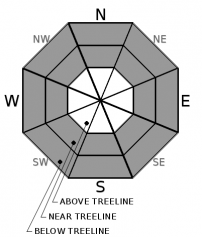| Wednesday | Wednesday Night | Thursday | |
|---|---|---|---|
| Weather: | Cloudy. Snow. Snow levels 7,000'. Chance of precipitation is 95%. | Mostly cloudy then becoming partly cloudy. Snow likely in the evening, then slight chance of snow after midnight. Snow levels below 7,000'. Chance of precipitation is 65%. | Partly cloudy. Snow levels below 7,000'. Chance of precipitation is 0%. |
| Temperatures: | 33 to 39 deg. F. | 23 to 29 deg. F. | 34 to 39 deg. F. |
| Mid Slope Winds: | Southwest 15 to 30 mph with gusts to 60 mph. | Southwest 15 to 30 mph. Gusts up to 60 mph decreasing to 45 mph after midnight. | Light winds. |
| Expected snowfall: | 75% probability of 5 to 10 inches. 25% probability of 3 to 7 inches. | SWE = 0.75 to 1.25 inches | 60% probability up to 4 inches. 40% probability up to 2 inches.| SWE = Up to 0.30 inch | No accumulation. | SWE = none |
| Wednesday | Wednesday Night | Thursday | |
|---|---|---|---|
| Weather: | Cloudy. Snow. Snow levels 7,000'. Chance of precipitation is 95%. | Mostly cloudy. Snow likely in the evening, then slight chance of snow after midnight. Snow levels below 7,000'. Chance of precipitation is 65% | Partly cloudy. Snow levels below 7,000'. Chance of precipitation is 0% |
| Temperatures: | 28 to 34 deg. F. | 21 to 26 deg. F. | 29 to 35 deg. F. |
| Ridge Top Winds: | Southwest 35 to 55 mph decreasing to 30 to 45 mph in the afternoon. Gusts up to 100 mph. | Southwest 30 to 50 mph with gusts to 90 mph. | Southwest 15 to 30 mph. Gusts up to 65 mph decreasing to 40 mph in the afternoon. |
| Expected snowfall: | 75% probability of 8 to 16 inches. 25% probability of 4 to 8 inches.| SWE = 1.00-1.50 inches | 60% probability of 1 to 5 inches. 40% probability up to 2 inches. | SWE = 0.15-0.40 inch | No accumulation. | SWE = none |














 The potentially problematic buried
The potentially problematic buried 












